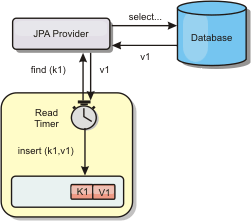Product overview > Cache > Database integration
|
| |
|
|
Database synchronization techniques
When WebSphere eXtreme Scale is used as a cache, applications must be written to tolerate stale data if the database can be updated independently from an eXtreme Scale transaction.
To serve as a synchronized in-memory database processing space, eXtreme Scale provides several ways of keeping the cache updated.
Database synchronization techniques
Periodic refresh
The cache can be automatically invalidated or updated periodically using the Java™ Persistence API (JPA) time-based database updater.The updater periodically queries the database using a JPA provider for any updates or inserts that have occurred since the previous update. Any changes identified are automatically invalidated or updated when used with a sparse cache. If used with a complete cache, the entries can be discovered and inserted into the cache. Entries are never removed from the cache.
Figure 1. Periodic refresh

Eviction
Sparse caches can utilize eviction policies to automatically remove data from the cache without affecting the database. There are three built-in policies included in eXtreme Scale: time-to-live, least-recently-used, and least-frequently-used. All three policies can optionally evict data more aggressively as memory becomes constrained by enabling the memory-based eviction option. See Plug-ins for evicting cache objects for further details.
Event-based invalidation
Sparse and complete caches can be invalidated or updated using an event generator such as Java Message Service (JMS). Invalidation using JMS can be manually tied to any process that updates the back-end using a database trigger. A JMS ObjectGridEventListener plug-in is provided in eXtreme Scale that can notify clients when the server cache has any changes. This can decrease the amount of time the client can see stale data.
Programmatic invalidation
The eXtreme Scale APIs allow manual interaction of the near and server cache using the Session.beginNoWriteThrough(), ObjectMap.invalidate() and EntityManager.invalidate() API methods. If a client or server process no longer needs a portion of the data, the invalidate methods can be used to remove data from the near or server cache. The beginNoWriteThrough method applies any ObjectMap or EntityManager operation to the local cache without calling the loader. If invoked from a client, the operation applies only to the near cache (the remote loader is not invoked). If invoked on the server, the operation applies only to the server core cache without invoking the loader.
Parent topic:
Database integration: Write-behind, in-line, and side caching
Related concepts
Related tasks